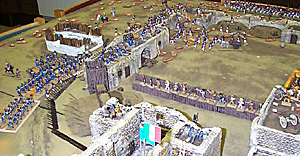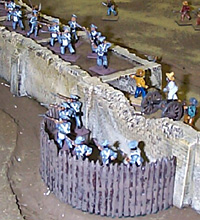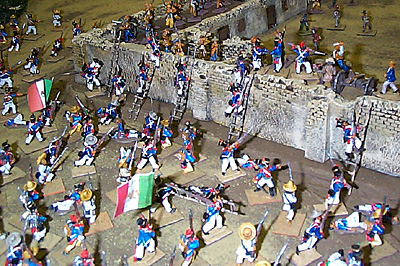 Each player is in the role of either a Mexican commander leading an assault column or a Texian commander in charge of a section of the fort. Players secretly issue orders each turn to their troops. Players may not confer with teammates unless their figures are within talking distance.
Each player is in the role of either a Mexican commander leading an assault column or a Texian commander in charge of a section of the fort. Players secretly issue orders each turn to their troops. Players may not confer with teammates unless their figures are within talking distance.
Possible orders include:
- RUSH: troops will move towards the enemy as quickly as possible, too fast to shoot.
ATTACK: troops will move towards the enemy at a steady pace, firing as they advance. THIS IS THE DEFAULT ORDER FOR MEXICANS WITH GOOD MORALE.
ASSAULT: troops will try to move into hand-to-hand combat with the enemy, deploying ladders and using axes as necessary if available. Any shooting is at point blank range and considered to be part of the hand-to-hand melee.
HOLD: troops will maintain their present position and facing and shoot at nearest visible enemy. This is the most effective shooting. THIS IS THE DEFAULT ORDER FOR SHAKEN MEXICANS AND FOR TEXIANS.
MANEUVER: troops will change facing or move according to the commander's shouted orders.
RETREAT or FALL BACK: troops will abandon their present position and move towards a location, which they perceive to be safer than their current one. THIS IS THE DEFAULT ORDER FOR SHAKEN TEXIANS AND ROUTED MEXICANS.
RALLY/RECOVER: troops will hold their position but attempt to recover morale and good order.

The referee will then move both sides' troops, taking into account movement obstacles such as ditches, doorways, ladders, etc. Retreaters can generally outrun attackers, but possibly may not outrun a rush.
Shooting
Shooting is then resolved, followed by melees, followed by morale tests, for each sector in turn.
Shooting factors are as follows:
If target is in the open, each ten infantry shooters (round 6 up, 5 down) rolls a D6 for enemy kills. If target is in light cover (1/3 of body), each 20 infantry rolls a D6; medium cover (1/2 body) each 30 infantry rolls a D6; heavy cover (3/4 body) each 50 infantry rolls a D6.
Artillery will kill 1D6 for each gunner, with an additional D6 if partial enfilade (45 degrees) and plus 2D6 if full enfilade.
Every time a 6 is rolled on shooting, one of the casualties inflicted will be a special figure such as commanders, officers, standard bearers, gunners, drummers, pioneers, etc. If more than one such special target is in range, referee will determine which one goes down.
Add 1D6 to shooting if unshaken firers on Hold orders.
Melee
 Melee factors are as follows:
Melee factors are as follows:
Begin with counting each side's figures engaged in the melee. Second rankers are assumed engaged. Troops not in the two front ranks are engaged if they can shoot into the melee, as in the case of Mexicans on the ground supporting a ladder assault.
Multiply number of engaged troops by modifiers as follows:
- defending doorway or similar narrow passage: X 20
defending stockade or wall or roof versus climbers: X 15
uphill or other slight advantage: X 2
Add the following factors to total as they apply:
- armed with bayonets facing enemy without: + 10
per each ladder deployed: + 10
per each pioneer with axe, if assaulting doors, windows, abatis, rooftop, etc.: + 10
per pip rolled on a D6: + 10
Texians size: + 10 (The average Texian was 5'8", the average Mexican 5'1")
Calculate total scores for each side. One enemy is killed for each 20 points scored by the winner, and for each 30 points scored by the loser.
Melee example: 8 Texians are defending a wall attacked by 32 Mexicans using three ladders. The Texians have 8 figures times 15 for the wall = 120; assume they roll a 3, for a total of 120 + 30 = 150 points. The Mexicans have 32, + 10 for bayonets, + 30 for ladders; assume they roll a 4 for another + 40, totaling 112. The Texians have a higher total and so kill 150/20 = 7 Mexicans (drop fractions); the Mexicans kill 112/30 = 3 Texians. If the Mexican player had rolled a 5 the Mexicans would have won with a total of 122, so casualties would have been 120/30 = 4 Mexicans and 122/20 = 6 Texians.
Morale
Morale calculations as follows:
Chance of Mexican column losing morale is number of casualties suffered this turn, expressed as a percentage. I.e., a column, which suffered 17 casualties in a turn, would have a 17% chance of losing morale. This is modified as follows: for each officer/drummer or bugler/pioneer/standard bearer lost this turn, increase probability of morale loss by 10%. So, for example, if Texians roll 4D6 and score 6, 6, 2, 1 for a total of 15, with two of the 15 being special figures, the Mexican column would lose morale on a roll of 35 or less on percentage dice.
First morale loss results in troops becoming shaken. Shaken troops will hold their ground and continue to fight, though less effectively, but will not advance towards the enemy. A second morale loss results in shaken troops routing. Routers will attempt to escape from danger by retreating to safety.
Chance of Mexican column regaining morale is calculated as follows: base chance is 10%, with an additional 10% for each officer and musician and standard bearer with the column. Mexican columns will check morale at the end of each turn in which they have suffered casualties, basing the die roll required on those casualties per a. above.
If a column begins a turn shaken or routed and its commander played the order RALLY/REFORM then it may immediately attempt to recover morale. If another order was played the column may attempt to recover morale at the end of that turn, after testing for any casualties suffered during the turn.
Mexican morale is increased when the soldados gain a foothold on the wall and when they break into the interior of the fort. For both types of morale checks, adjust a successful roll by 10 if at least ten Mexicans from that column are on the wall, by 20 if at least ten are inside the walls, and by 10 if a standard (of any column) is visible atop a wall or building.
Unshaken Mexicans automatically recover their standard and pick up dropped ladders and axes. (That is, immediately replace the figure after counting the casualty.) Shaken Mexicans do not pick them up – that is, when a shaken column loses a standard bearer etc, the figure is removed from play.
Texian morale is tested at the end of any turn in which it might fail, i.e. if any of the negative factors below apply. Texian morale starts at 100% and is reduced by 10 for each factor that applies.
The Texians being tested must be able to see the relevant factors (within 12"):
- At least 5 Mexican have a foothold on the wall: - 10
Mexicans visible on each side on wall or inside perimeter: - 10
Mexicans inside walls: - 10
Other Texians retreating: - 10
POSITIVE Texian factors include cornered (+ 10),
and Crockett or Travis within 6" (+ 10)
Texians who fail morale are shaken; they will try to retreat unless cornered.
Back to War Lore: The List
Back to Master Magazine List
© Copyright 2000 by Coalition Web, Inc.
This article appears in MagWeb (Magazine Web) on the Internet World Wide Web.
Other military history articles and gaming articles are available at http://www.magweb.com